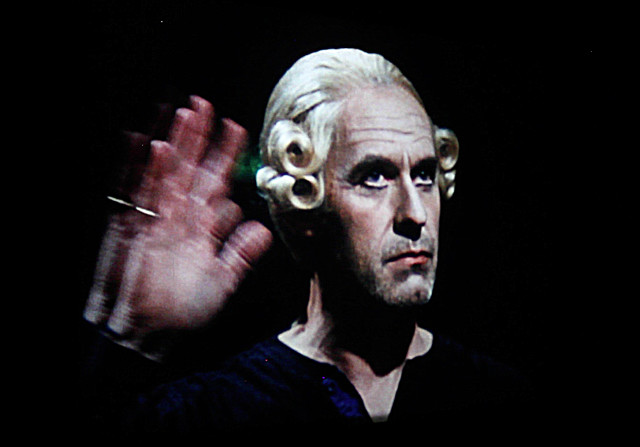
THE DAILY PIC (#1521): For many years I’ve felt certain that Tacita Dean’s quiet, almost static films would make her go down as one of the great artists of our era. That made me all the more surprised to find that her latest gift to posterity is a movie full of sound and fury, signifying … a great deal.
For most of March Marian Goodman Gallery in New York has been showing Dean’s astounding Event for a Stage, from which the still in today’s Pic has been taken. (Click on it to see a little clip shot at one screening.)
The premise behind the piece is simple. For the 2014 Sydney Biennial, Dean hired the actor Stephen Dillane to perform a one-man show she’d prepared about the nature of theater; the new film is just a compilation of clips from the show’s four performances. But if that premise is easily grasped, the work’s actual content, and Dean’s treatment of it – both as it played out on the stage and then in her miraculous editing of the footage – are complex beyond belief. (And certainly beyond dealing with properly in the dozen or so sentences of a Daily Pic.)
Let’s just say that the slippages between reality and fiction that all drama is built around are perfectly distilled into the 50 minutes of Dean’s film. We never know when Dillane is just being himself, when he’s playing a rather actor-ish character who happens also to be named Stephen Dillane and when he’s playing yet another role – The Actor – that Dean has written for him. When he voices complaints about the quality of Dean’s script, is he speaking on his own behalf or in his role as the Actor? Or are the complaints themselves in fact written into the “bad” lines that Dean has given Dillane to perform, and to gripe about?
Dean shows up on screen too, by the way, for the first time that I’ve ever seen in her work, but maybe she too is not really there as herself, but in the guise of an actor who happens to be playing an artist named Tacita Dean, who is herself playing the role of director and author.
One theme in the piece is a constant, palpable tension between Dean, the visual artist who has never before worked with an actor (or as one) and Dillane, the actor who has never suffered the slings and arrows of art’s abstractions. But were those tensions real, in the theater in Sidney, or were they cobbled together in good humor by Dean and Dillane before they ever met their audience? After all, the movie that we are watching in the gallery has been assembled from four nights’ worth of footage (we can tell because Dillane put on a new wig each night) so it seems unlikely that truly unrehearsed emotions would survive unchanged from performance to performance. But who knows if in fact they did? Dean the filmmaker is utterly in control of what we get to see, so it could be that it’s a mistake to imagine that the perfect, seamless fiction of her filmic piece has anything much to do with what happened on stage.
There, I’m already at seventeen sentences, and have barely begun to unpack the piece.
My only cavil is that I honestly found the whole thing too short. To achieve perfect conceptual integrity, Dean’s ambitious work about the nature of drama needed to fill up at least the two hours of The Tempest, from which it quotes, and maybe even the four hours of Hamlet. But then I’m the guy who watched Empire whole, and enjoyed it.
For a full survey of past Daily Pics visit blakegopnik.com/archive.